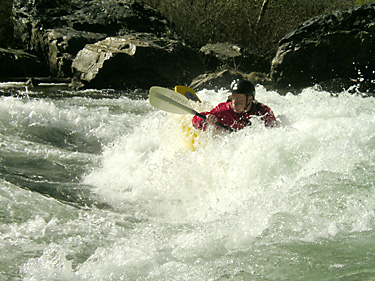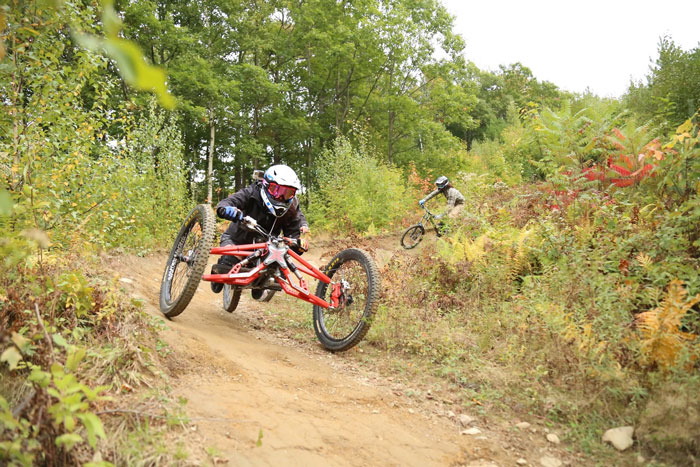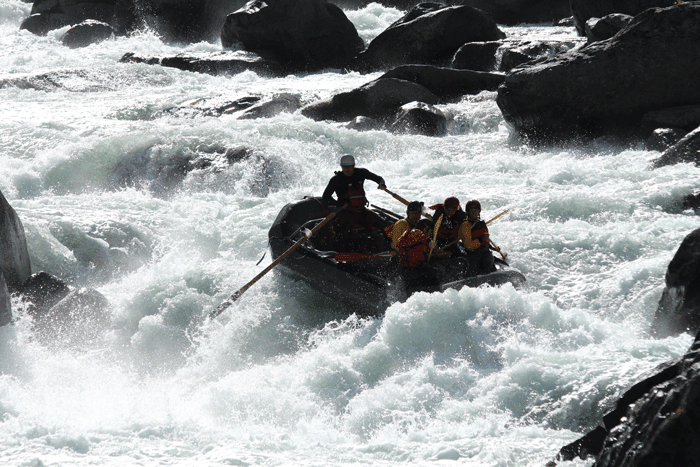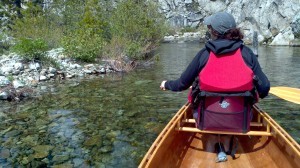- Tahoe’s Nevada Beach Tops the List of Hard-to-Book Campgrounds - 07/17/2024
- Cannabis Watershed Protection Program Cleans Up Illegal Grow Sites - 07/10/2024
- French Fire - 07/05/2024
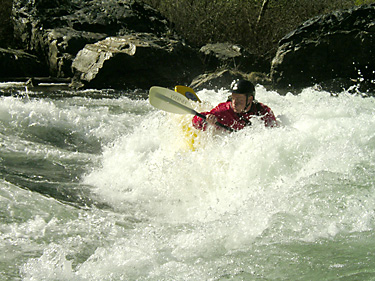
A Playboating Primer for Budding Kayakers
By Geoff Jennings
Geoff Jennings cartwheeling in a hole. Photo by Damian Mann
Playboating is a sub-discipline of whitewater kayaking that focuses on doing tricks and maneuvers in the river. It can take many forms, from the casual boater doing a stern squirt, to spending an hour cutting up a wave on the way down the river, to dedicated play missions, where challenging a specific play feature is the entire goal for the day. Playboating can be done on flatwater and in eddylines, as well as on waves and in holes.
For many kayakers, perfecting increasingly complex tricks becomes the focus of their paddling. For others, it’s merely a challenginGeoff Jennings cartwheeling in a hole. Photo by Damian Mann.g diversion to mess around with on the river.
But no matter what your focus in paddling is, time spent experimenting with playboating will improve your boat-handling and paddle skills, increase physical strength and up your confidence in all facets of paddling. Ending up in a hole during a creek run won’t be as terrifying when you’ve spent your summer throwing yourself into them. Learning the skills for one trick leads to another, and builds skills for all types of paddling.
In a low-runoff year like this one, playboating is probably the best way to keep yourself entertained and sharpen your skills. Popular play spots on dam-controlled rivers like the South Fork American, the Tuolumne and the Trinity should have fun flows through the summer.
SAFETY
As with any paddling, always go in a group, and be prepared to swim. Make sure your crew is prepared to assist each other, that there are throw ropes available. It can be tempting to go “park-n-play” solo, but you reduce your safety margin significantly. It’s easy to let things get relaxed when playboating, but accidents and injuries do occur.
GEAR
Modern playboats are pretty specialized machines, and range from really short, high-volume machines designed for aerial moves (like the Dagger Agent or Wavesport Project) to longer boats with more river-running ability (like the Pyranha Recoil or LiquidLogic CR series).
SURFING
This is the most basic form of playboating. It’s tons of fun on its own, but it’s also a requisite skill for nearly every trick. To learn, look for a small- to medium-sized wave with good eddy access. Paddle up the eddy, then ferry across from slightly upstream of the wave, facing upstream. Use a standard upstream ferry to cross the eddy line and approach the wave. Just as you are about to connect with the foam pile on the wave, turn the boat straight perpendicular to the face of the wave, and, if necessary, paddle forward in a few rapid strokes to keep from getting spit off. Done right, and you’ll soon feel the acceleration as the wave grabs you and holds you in place with few if any paddle strokes required, other than to correct your positioning.
Once on the wave, you can adjust your position in two ways. Leaning forward will generally accelerate you down the wave, while leaning back will slow you down. On most waves you’ll need to make subtle but near constant adjustments to your position to stay on the wave to keep from pearling (your bow gets buried by the green water entering the wave) or getting bucked off the back.
One of the best ways to control your position on the wave is by carving back and forth. This is best done by edging with your boat. To carve to the left, lift your right knee and shift your weight slightly to the left, which will engage the left edge, and carve the boat. Be prepared to make small adjustments and shift quickly back to the other side, as things often happen very quickly. Play with this, and you’ll soon be carving up river waves like a bird rising and falling in the thermals.
SPINNING
This is a variation on surfing. As you carve your turn, continue to change edges and shift your weight such that you always have the upstream edge lifted. If you don’t, you’ll know it – you’ll be flipped in a hurry. Always lead with your head, looking in the direction you want to turn. If you’re spinning to your left, you should look over your left shoulder the whole time. This twists your body such that it leads you and your boat through the spin. You can use sweep paddle strokes to pull yourself through the spin if you need more momentum, but on most features you should be able to control the spin primarily through using your edges.
STERN SQUIRTS
This is probably the easiest way to get vertical. Find a strong eddy line. Start to paddle across it, as if doing a typical eddy peel out. Let’s assume we’re on river right, facing upstream. As you paddle across the eddy line, keep the boat flat. As your boat begins to turn downstream, twist your entire body to the right, and do a strong stern pry paddle stroke on the right side. This should push the stern into the eddyline and the downstream flow, where you will feel it load and sink. Although counterintuitive, lean forward to sink the stern more, and begin to unwind your body. Putting your paddle over your head to brace, and adjusting your forward and aft position turns this into a stern stall.
BOW STALL
This is a good flatwater move to practice getting vertical and to develop better boat control and balance. Paddle quickly forward, and once you have a little speed, put the boat on edge while simultaneously lifting the bow with a strong forward stroke. At the end of the stroke, immediately do a strong reverse stroke on the same side, while throwing your weight forward. Remember that your boat is on edge the whole time. I like to picture trying to put my face where my feet just were. This move takes a little muscle, but in a properly-sized modern playboat, strength should not be an issue. As the boat becomes vertical, brace with the paddle blade that wasn’t used in initiating the rotation. End with your tail in the air, your arms outstretched in the water. Adjust for boat rotation with braces from the paddle. Adjust your vertical angle by leaning forward to lower boat angle, and leaning back to steepen. It’s backwards, I know, but it works. I’m sure someone smarter than me could explain the physics.
CARTWHEELS
At this point we’re really beyond beginner moves, but the cartwheel is just an extension of the bow stall, and therefore part of a logical playboating progression. It can be done in flatwater, but you might find it easier to learn in a small hole or pour over spot. Start just like the bow stall, placing the bow of the boat in the downstream flow. As the boat goes vertical, look in the direction of rotation, toward the point where you want the ends to intersect. Quickly rotate your body around, making sweeps with the paddle a quarter turn ahead of the boat, always leading with the body. It’s easier to see, and even do, than describe. But the idea is that a boat on edge, lead by a twisting body, will rotate around your center. Don’t try shift your weight back and forward as the ends swap, or you’ll never succeed.
It takes time and patience to master these skills, but you’ll notice an improvement in your paddling quickly. Rolls will be quick and automatic, and you’ll find your boat control is much better. And, of course, it’s fun. The first time you nail a multiple-point cartwheel, you’ll be giddy as a school kid that just aced his last test.

